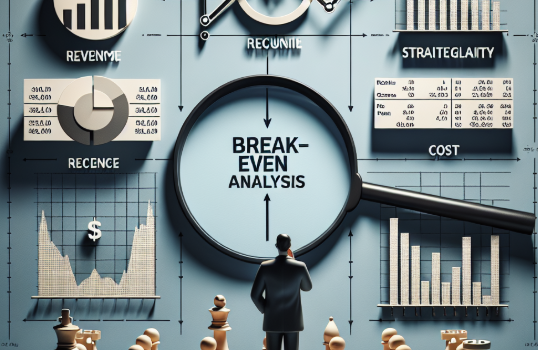
Break-even analysis is a critical tool that helps businesses understand the point at which their revenues cover their costs, enabling them to make better financial decisions. Whether you’re launching a new product, expanding into new markets, or managing day-to-day operations, this analysis provides vital insights to guide pricing strategies, sales targets, and overall profitability. In this guide, we’ll break down the process of calculating break-even points, explain how it works in various business scenarios, and offer practical tips for using break-even analysis to make more informed decisions.
What is Break-Even Analysis?
Break-even analysis is the process of determining the point at which a company’s total revenue equals its total expenses, meaning it’s neither making nor losing money. This is a key metric that businesses use to assess their financial health and to set sales goals. The break-even point is particularly helpful for pricing strategies, controlling costs, and assessing the impact of changes in fixed and variable costs. By understanding this concept, businesses can ensure they are on track to cover their expenses and start generating profits.
Why is Break-Even Analysis Important?
The main benefit of break-even analysis is its ability to help businesses calculate the minimum sales needed to cover all costs. This allows business owners to make informed decisions regarding pricing, cost management, and sales goals. With a clear understanding of the break-even point, businesses can better evaluate the impact of cost changes, new product pricing, or changes in sales volume. It serves as a valuable tool for creating effective financial plans and strategies for both short-term and long-term business success.
How to Calculate Break-Even Point
To calculate the break-even point, you need to understand both fixed and variable costs. Fixed costs are those that do not change regardless of how much product is sold (e.g., rent, salaries), while variable costs change with production or sales volume (e.g., raw materials, direct labor). The break-even point can be calculated using the following formula:
Break-Even Point = Fixed Costs / (Selling Price per Unit – Variable Cost per Unit)
This formula will give you the number of units you need to sell to cover all your costs. Calculating this number allows businesses to set realistic sales goals and understand the level of sales required to start making a profit.
The Role of Fixed Costs
Fixed costs are essential in determining your break-even point because they remain constant, no matter how many products you sell. These costs include things like rent, salaries, and insurance. Since these costs are unavoidable, they must be covered by your revenue before you can start making a profit. A solid understanding of your fixed costs is crucial in pricing your products effectively and planning for future growth.
The Significance of Variable Costs
Variable costs fluctuate depending on the amount of product you produce or sell. These costs include things like materials, packaging, and shipping. They directly affect your profit margins and the break-even point. By analyzing and controlling these costs, businesses can improve their profitability and ensure they are operating efficiently. Keeping variable costs low can reduce the number of sales required to break even, ultimately boosting your bottom line.
Contribution Margin: A Key Indicator
The contribution margin is the amount remaining from sales after variable costs are subtracted. This margin is crucial because it indicates how much revenue is available to cover fixed costs. The higher the contribution margin, the fewer units you need to sell to reach the break-even point. Understanding this metric helps businesses assess the profitability of individual products and identify areas for improvement in pricing and cost control.
Using Break-Even Analysis for Different Business Scenarios
Break-even analysis can be applied in a variety of scenarios, whether you’re launching a new business, introducing a new product, or adding a new sales channel. Here’s how it can help in each case:
For New Businesses
For startups, break-even analysis is essential for determining how much revenue you need to generate to cover your expenses. It helps set realistic sales goals and guides decisions on pricing, cost structure, and funding requirements. New businesses can use break-even analysis to assess financial viability and develop strategies for growth.
For New Products
When launching a new product, break-even analysis helps determine how much of the product needs to be sold to cover production costs. This analysis can also guide decisions about product pricing and marketing strategies, ensuring that the new product will contribute positively to overall profitability.
For New Sales Channels
Expanding into new sales channels—whether it’s online, through partnerships, or in new geographical markets—requires careful financial planning. Break-even analysis can help businesses evaluate the financial impact of these new channels, allowing them to determine if the additional investment is worth the potential return.
Overcoming Challenges in Break-Even Analysis
While break-even analysis is a powerful tool, it does have limitations. For example, it assumes that costs and sales prices remain constant, which is rarely the case in a dynamic market. It also doesn’t account for market demand changes or the competitive landscape, which can significantly influence profitability. Despite these limitations, break-even analysis remains a valuable tool for setting pricing strategies and planning for growth.
Practical Tips to Lower Your Break-Even Point
To make the most out of break-even analysis, businesses should focus on reducing both fixed and variable costs. Here are a few tips to lower your break-even point:
- Reduce Fixed Costs: Renegotiate contracts, outsource non-essential tasks, and optimize operations to lower fixed costs like rent and salaries.
- Increase Prices: If feasible, raising your prices can reduce the number of units you need to sell to break even.
- Lower Variable Costs: Negotiate better deals with suppliers, reduce waste, and implement cost-saving technologies to cut variable costs.
Break-Even Analysis in E-Commerce
For e-commerce businesses, break-even analysis is invaluable. It helps in determining pricing strategies, assessing the viability of new product lines, and optimizing the use of marketing budgets. It also assists in identifying the profitability of various sales channels and helps guide decisions on fixed costs like warehousing and logistics.
Using Break-Even Analysis for Future Planning
Break-even analysis isn’t just about understanding when you’ll break even—it’s also a tool for smarter future planning. It helps businesses predict financial needs, plan for loan repayments, and create flexible strategies for scaling operations. By regularly revisiting your break-even point, you can adjust your plans as needed, ensuring that your business remains on track for sustained growth.
Conclusion
Break-even analysis is an essential tool for businesses of all sizes. It provides valuable insights into how many units need to be sold to cover costs, allowing businesses to set effective pricing strategies, sales targets, and financial goals. While there are some limitations to the analysis, its benefits far outweigh the drawbacks. Whether you’re launching a new business, introducing a new product, or expanding into new sales channels, break-even analysis can guide your decision-making and help you manage growth effectively. By applying break-even analysis regularly, you can keep your business on track for long-term profitability and success.









